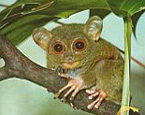|
Philippine
Tarsier
(Tarsius syrichta) #61-193 |
||||
|
|
Physical
characteristics and distribution
|
|
Head
and body length is 85-160 mm, tail length is 135-275 mm. Adults
weigh between 80-165 grams. The silky, wavy fur is buff or grayish
to dark brown above and buff grayish or slate below. The naked
tail has a few short hairs at the tip. The most outstanding
feature of T. syrichta is its very large eyes, the diameter
of the eyeball being about 16 mm. The round head has a short,
flattened muzzle and the neck is also short. Tarsiers differ
from other lemurs in that the face is furred with short hairs
ending at a narrow strip of naked skin around the nostrils.
The muzzle is moist with a central prolongation dividing the
upper lip. The forelegs of T. syrichta are short while
the hind limbs are greatly elongated. The name Tarsier refers
to the unusually long tarsal, or ankle. The long digits are
tipped with rounded pads that allow T. syrichta to grip
almost any surface. The thumb is not truly opposable, but the
first toe is. All of the digits have flattened nails, except
for the second and third toes, which have sharp claws that are
used for grooming. |
|
Description
of the brain
|
|
Animal
source and preparation
|
|
All
specimens collected followed the same preparation
and histological procedure.
|
Other Related Resources (websites and publications)
List of Specimens | Explore Collections | Brain Sections | Brain Evolution | Brain Development | Brain Circuitry | Brain Functions | Location and Use | Related Web Sites | Contact Us | Search MSU Database | Personnel | Home



